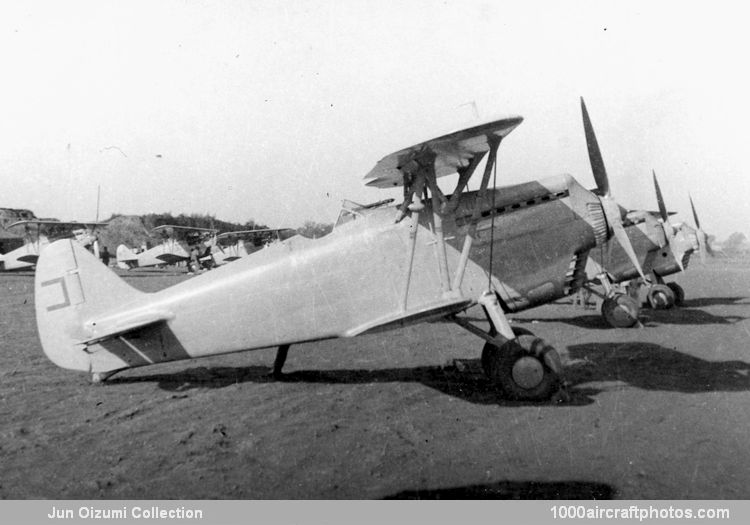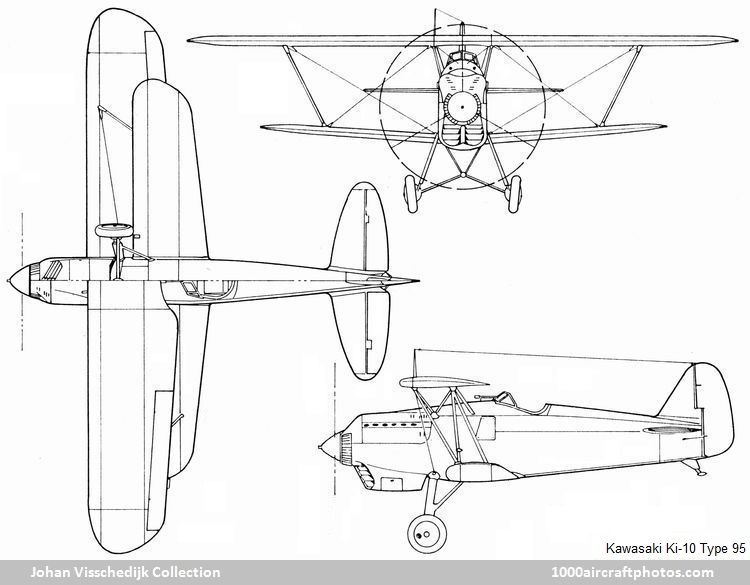In the early 1930s the fighter units of the Imperial Japanese Army were equipped with Nakajima NC (Army Type 91 Fighter) monoplanes and with Kawasaki KDA-5 (Army Type 92 Fighter) biplanes, but both types of aircraft were markedly slower than the Hawker Fury then used by the RAF and the Boeing P-26A then being delivered to the USAAC. In an attempt to produce in Japan a fighter aircraft equal or superior to contemporary foreign types, in 1933 Kawasaki had designed the Ki-5, a clean inverted gull-winged cantilever monoplane, but in 1934 it was rejected by the Army as tests revealed that its maneuverability was unsatisfactory. In September 1934, shortly after the Ki-5's development had been discontinued, the Koku Hombu instructed Kawasaki to design a high-performance fighter biplane while Nakajima were asked to develop a competitive fighter monoplane.
Designed by Takeo Doi with the assistance of Engineers Imachi and Tojo, the single-seat Kawasaki Ki-10, of all-metal structure with light alloy and fabric covering, was a clean-contoured open biplane of unequal span with ailerons fitted to the upper wing only. Powered by an 850 hp Kawasaki Ha-9-IIa twelve-cylinder liquid-cooled V-engine driving a two-blade fixed-pitch propeller, the first Ki-10 prototype was completed in March 1935 and was followed a month later by a second, identical, aircraft. Early flight test results confirmed that the aircraft was markedly superior to the unsuccessful Ki-5 in speed as well as in maneuverability.
However, the competitive Nakajima Ki-11 with its low-wing monoplane configuration was still faster and Kawasaki feared that the production contract would go to Nakajima. Every effort was made to improve speed and the third prototype was fitted with a three-blade metal propeller in place of the two-blade wooden airscrew used on the first two aircraft, and flush-head rivets were adopted. The fourth prototype was identical with the exception of the upper wing which featured increased dihedral to improve stability. Even so modified the Ki-10 was still slower than the Ki-11, but the gap had been sufficiently reduced for the Ki-10 to win a large production contract on account of its exceptional maneuverability. Identical to the third prototype, the Ki-10-I, designated officially Army Type 95 Fighter Model 1, was built between December 1935 and October 1937.
When placing a production contract for the Ki-10-I, the Army had instructed Kawasaki to initiate a development program aimed at improving the aircraft's stability. For this purpose the 185th Ki-10 was fitted with wings of increased span and area, and with a lengthened fuselage. First flown in May 1936, flight test results showed a marked improvement and the aircraft served as a prototype for the Ki-10-II series which went into production as the Army Type 95 Fighter Model 2, beginning in June 1937 ending December 1938.
In April 1936, design of a cleaned-up version began and the 200th Ki-10 airframe was completed in October 1936 as the Ki-10-I KAI. The large radiator was moved back from under the engine cowling to between the redesigned low-drag cantilever landing gear with internally sprung wheels covered by drag-reducing wheel covers. At the same time the engine cowling, still housing an Ha-9-IIa, was cleaned-up. During tests a maximum speed of 261 mph (420 kmh) was reached, this speed exceeding that of the standard Ki-10-I by some 12.5 mph (20 kmh).
In November 1937, two generally similar Ki-10-II KAI were produced by incorporating the aerodynamic improvements of the Ki-10-I KAI into Ki-10-II airframes and, powered by the Ha-9-IIb (with a maximum rating of 950 hp at 12,470 ft (3,800 m) for short periods) and a three-blade metal propeller, they reached a top speed of 276.5 mph (445 kmh). Despite a maximum speed almost equal to that of the Nakajima Ki-27 fighter monoplane, the Ki-10-II KAI remained in prototype form as it was obvious that the heyday of the biplane combat aircraft was over.
The Ki-10-1 and Ki-10-11 saw service with units of the Japanese Army in Japan, Formosa, Korea and Manchukuo and participated in combat operations in China and Manchuria during the second Sino-Japanese conflict and the Nomonhan Incident. However, when the Pacific War began the Ki-10 had been relegated to training and other ancillary duties. Allied intelligence officers, who early in the war still believed the aircraft to be in first-line service, assigned to it the code name Perry but aircraft of this type were only occasionally encountered over China.
In all, 588 Ki-10s were built by Kawasaki Kokuki Kogyo K.K. at Gifu:
|
4 |
|
Ki-10 prototypes |

